 Features
Features

With colours as words and patterns as symbols, Chăm artisans in the Mekong Delta province have been passionately creating stories through weaving.
by Minh Nguyễn
With colours as words and patterns as metaphors, ethnic Chăm artisans in the Mekong Delta province of An Giang passionately create stories through weaving.
Saymah is working on a handloom when I visit her family’s craft shop. She is among the experienced weavers of the Chăm community in Phũm Soài Village in Tân Châu District. Her husband, Mohamad, is the third generation of a family pursuing traditional handloom weaving.
Their shop is small but full of handloom fabrics with colourful and charming patterns. Weaving is the language they use to create stories from threads.
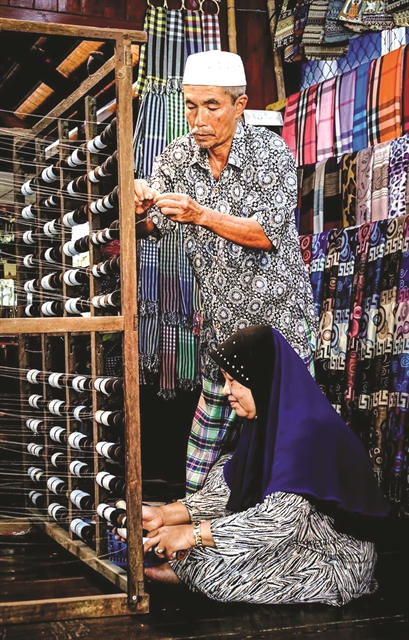
|
| SPINNING TALES: The couple continue to tell stories through the tradition of Chăm weaving. VNS Photo Hồng Minh |
Colours as words, patterns as metaphors
“Learning how to weave is like learning a language. You need to start with basic words,” the 58-year-old Saymah says.
By words she means colours. The five basic colours of Chăm fabric are red, white, yellow, blue, and black. Not only do Chăm weavers learn to remember and classify these colours as warm and cold tones, they also learn to dye the yarns themselves.
In the past, colour pigments were made from natural plants around their home: green from leaves, red from resin, yellow from tree bark, and black from ebony fruit (scientifically named Diospyros mollis).
According to Saymah, what sets the Chăm traditional textile art apart from, say, its northern ethnic counterpart, is the dyeing technique. Chăm people have traditionally dyed their threads before setting up the looms, while weavers in the north have usually done it the other way around.
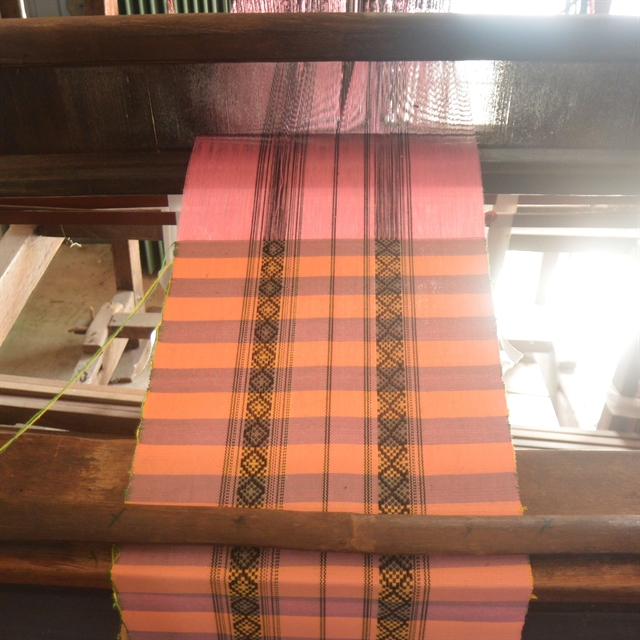
|
| BEYOND APPEARANCE: Patterns as metaphors of nature, work, and life. VNS Photo Hồng Minh |
Nowadays, natural dyes are rare, with local people turning to colourants instead. But the lessons from hand-made colours help Chăm weavers select the right shades and blend them into their products.
Chăm weavers also speak through patterns as metaphors of their language.
“Chăm cloth patterns are somehow abstract,” Saymah says. “Common patterns include squares, suns, clouds, flowers, and animals. They depict nature and the daily working life and customs of the Chăm.”
However, just as languages change over time, with newly invented or borrowed words or meanings, Chăm fabric patterns have also evolved.
“We create complex shapes and patterns from simple motifs, such as four-pastel colours in a square,” she explains. “We also adopt new patterns and combine them with traditional ones to diversify our products, while still retaining the authenticity of Chăm handloom textiles.”
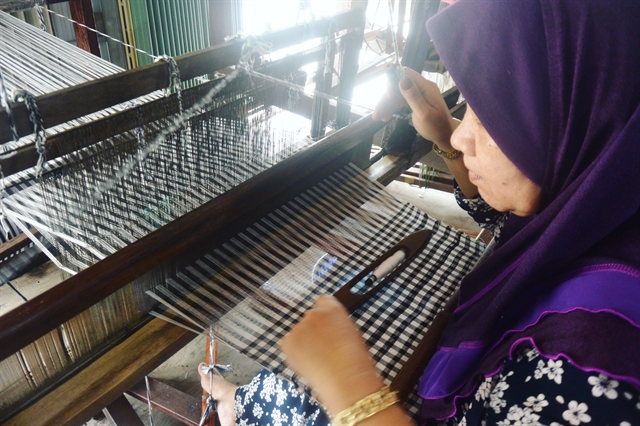
|
| CREATION: Telling stories through threads on a handloom. VNS Photo Hồng Minh |
Like writing a story on fabric
But weaving is the final step of the whole process, and there are several steps needed for Chăm weavers to tell their stories.
While writers need a plot, some characters, and imagery to compose their stories, “weavers must know what they are going to make, then structure the yarn cones, set up the looms, and create patterns,” Saymah says.
For weavers, threads and looms are like pen and paper. The equipment used in Chăm handloom weaving is, however, quite sophisticated and requires patience and attentiveness on the weavers.
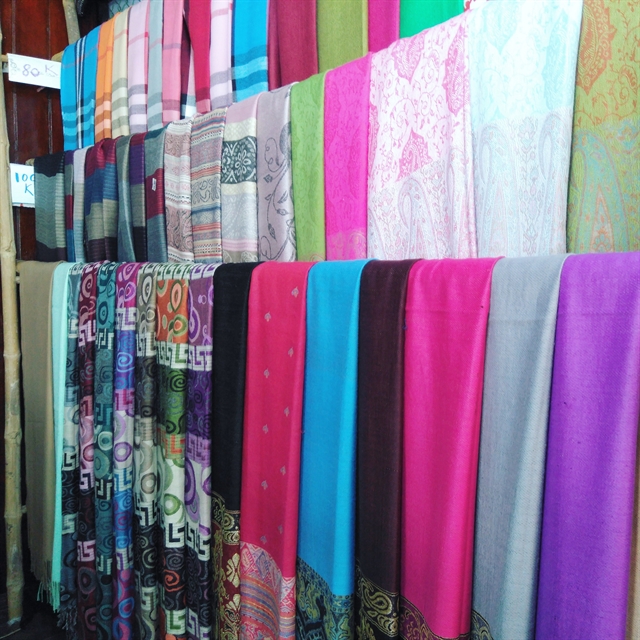
|
| WOVEN CLASSICS: Masterpieces of colour, patterns, and creativity. VNS Photo Hồng Minh |
According to artisan Saymah, yarns are wound onto cones and framed on a warping mill. This step is done twice - the first time for measuring the size of the fabric and the second for creating patterns, usually taking three to five days to finish.
After that, weavers can start building their “characters”, or products, by creating patterns on the looms.
“Each craft is characterised by patterns, and the most striking feature of Chăm weaving is making patterns emerge on the fabric without being overshadowed by colour shades,” Saymah says.
The job of the weaver is to creatively and harmoniously manipulate colours and the density of the threads, making the “metaphors” echo, she adds.
Each product and its patterns require frames created from different numbers of poles. “Weavers therefore also need to prepare their poles accurately. Some patterns need 10 poles, while others might need 18 or even more,” the artisan explains.
Once all the materials are ready, it is time to weave, or write a story with the language of threads.
Passion last but not least
“There is no particular formula for weaving,” Saymah says, adding that it all boils down to the creativity, craftsmanship, and enthusiasm of the weavers.
Weavers are the artists who bring items to life. Without passion, products are emotionless and won’t be welcomed by customers, like a story that doesn’t touch the soul of the reader.
A passion for weaving and preserving its origin is what has kept the couple pursuing the tradition for more than 40 years, despite it being time-consuming and meticulous.
“We could afford a power loom, which would help us weave faster, but that’s not the characteristic of Chăm handloom fabrics,” Mohamad says.
“Handicraft weaving takes time, but the products are more authentic and durable. Running the business allows us to retain the tradition and do what we love.”
They have passed this love on to their family members and to others in the village. Mohamad has taught the craft to both their sons and their daughters, though the tradition is normally only handed down to girls.
With support from local authorities, the couple have also trained other local people to make traditional fabrics and become the next storytellers.
“We have a strong belief that our community’s stories on handloom fabric will be carried on,” Saymah says, smiling as brightly as the sun, whose light was dancing in sync with the sound of the loom she is working on. VNS
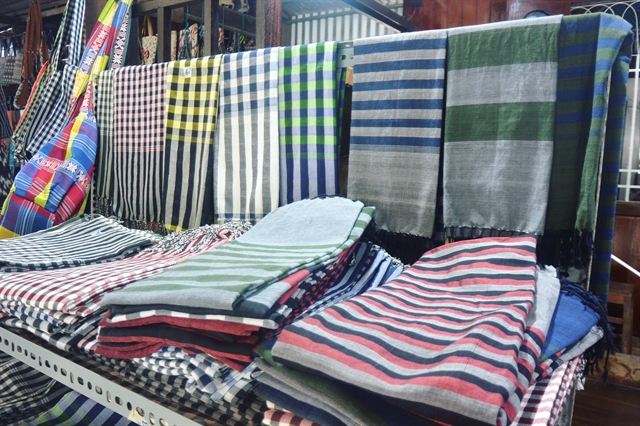
|
| TALES OF WARMTH: Scarves with different colours and patterns. VNS Photo Hồng Minh |